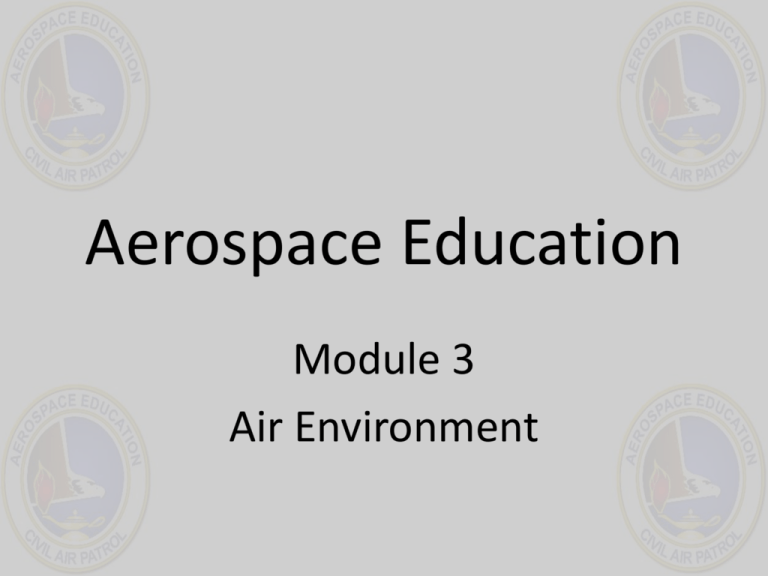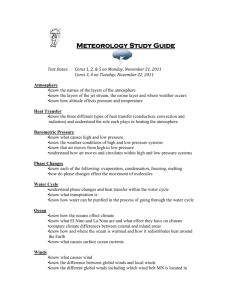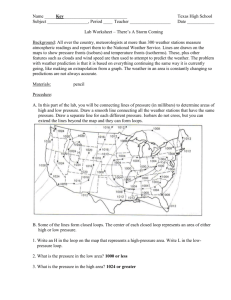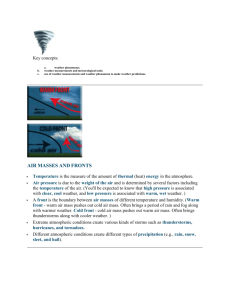AE Module 3 Presentation
advertisement

Aerospace Education Module 3 Air Environment Contents • • • • • • Chapter 1 – Air Circulation Chapter 2 – Weather Elements Chapter 3 – Moisture and Clouds Chapter 4 – Weather Systems and Changes Quiz Credits Chapter 1 “Air Circulation” Radiation The method through which the Sun heats the Earth is called radiation. The energy produced by the Sun radiates into the Earth’s atmosphere and this energy is absorbed unevenly depending on the surface or substance. About 50% of the solar radiation is absorbed by the surface of Earth, the other 50% is reflected back and absorbed by the atmosphere or radiates back into space. Contents Rotation and Revolution The has two motions that affect the amount of heat received from the Sun. These motions are it’s rotation and revolution. Our orbit around the Sun is our revolution, which takes 365 days, 5 hours and 48 minutes. While it revolves, the Earth is tilted on it’s rotational axis by 23.5°. Contents This axis tilt causes the length of days to vary as well as cause our seasons. As different areas of Earth are tilted towards and away from the Sun, they receive less or more energy from the Sun, which we perceive as seasons. Rotation and Revolution Contents The Coriolis Effect The Coriolis Effect is a result of the Earth’s rotation. As the Earth rotates on it’s axis, it creates wind moving in a counterclockwise motion. This wind causes objects moving in a straight line North or South to be deflected to the West. Contents Circulation The uneven heating of Earth causes the movement of the air. When on a global scale, this is called the general circulation of the atmosphere, or circulation. Basically, this general circulation is the world-wide system of wind which transfers heat from the tropical regions to the polar regions. Contents Circulation The area of Earth which receives the most energy from the Sun is the equatorial region. This energy shows itself after moving about 30° North or South of the equator where the warmed equatorial air begins sinking and moving back towards the equator. This causes steady, warm, and almost continuous breezes. The Coriolis Effect causes these winds to curve to the West. These winds are known as the trade winds. Contents Circulation When the trade winds converge on the equatorial region, the converging winds cause a general upward wind as the cooled air is heated once more. This causes the equator to have no steady surface winds. This calm, equatorial region is known as the doldrums. Contents Circulation As you move farther North or South from the equator, between 30° and 60° latitude, you encounter winds blowing towards the poles which curve to the East. These winds are known as Prevailing Westerlies, after the direction in which they originate. Contents Circulation Once you reach approximately 60° latitude in either hemisphere, the Prevailing Westerlies begin joining with Polar Easterlies to cause another upward motion. The Polar Easterlies form as the atmosphere over the poles cools and sinks. This air then spreads out over the surface and is curved to the west by the Coriolis Effect. They receive their name by their direction of origin, the East Contents The Jet Stream The Jet Stream generally crosses the United State at about 30-35,000ft., moving West to East. The Jet Stream develops due to strong temperature differences in the upper troposphere. These large differences cause large pressure differences, which in turn create stronger winds than usual. The Jet Streams typically blow at between 120-150mph, with recorded speeds of up to 450mph. Contents It snakes for thousands of miles across the United States, hundreds of miles wide and several miles deep. During the Winter months it is generally stronger and moves farther South. Aircraft flight plans often take the jet stream in mind and use it to their advantage or avoid it. The Jet Stream Contents Chapter 2 Weather Elements Wind Wind is a body of air in motion which has direction and speed. Wind direction is determined by the direction in which the wind is coming from. Wind speed is expressed in either miles per hour or knots. 1 Knot is 1 nautical mile per hour. A nautical mile is 6,076 feet, or approximately 1.1 miles. There are several ways of estimating wind speed, such as using a flag or the Beaufort Scale. Contents Wind Wind, as the name indicates, also causes Wind Chill. As wind blows away the warm air directly around your body, your body tries to warm the air up again, causing it to lose heat. The harder the wind is blowing, the faster the warm air will be taken away and the colder you will feel. Contents Wind Wind has a vast multitude of odd phenomena that it shows itself in. One of these phenomena is a microburst. Microbursts have been responsible for many aircraft crashes, primarily during takeoffs and landings. Microbursts are downdrafts associated with unstable air, cumulus clouds, and thunderstorms. As these microbursts occur, an aircraft entering one will first encounter a stronger headwind, causing more lift. Contents To counter this, the pilot will point the nose down and decrease thrust. As the aircraft flies through it, it may encounter a tailwind, pushing the nose down even farther and reducing lift. If the aircraft is close to the ground, such as during a takeoff or landing, it may not have time to recover, causing it to crash. Wind Contents Wind Contents Temperature Heat is the total energy of all molecules within a substance. Heat is also extremely relative, especially when expressed in temperature. Temperature is a measure of molecular motion expressed on a man made scale in either Fahrenheit, Celcius, or Kelvin. Contents Celsius is the metric measurement for temperature, with 0° and 100° being water’s freezing and boiling points. Kelvin is a scientific measure, where 0° is absolute zero. Fahrenheit is the English system measurement for temperature with 32° and 212° being water’s freezing and boiling points. Temperature Contents Pressure The push of the weight of the atmosphere upon us is called atmospheric pressure. Air pressure is measured by a mercurial barometer, an aneroid barometer, or an aneroid barograph. An aneroid barometer is the easiest to read and are often found in homes and offices on walls. Mercurial barometers are not as easy to read, but are more reliable and more stable. Aneroid barographs give permanent records of pressure and are therefore found in weather stations around the country. Contents Chapter 3 Moisture and Clouds Moisture Moisture is absolutely pivotal to our weather, it’s one of the driving forces behind it. Water vapor is always present in our atmosphere to some degree. As more and more water vapor is in the air, it begins becoming saturated. The air becomes saturated at different levels of humidity at different temperatures. The temperature at which air becomes saturated is it’s dew point. Contents Once an air mass is saturated, any more water vapor it receives condenses into a liquid form. This process is called condensation. Clouds and fog are both products of condensation. Fog Fog is formed of tiny droplets of liquid water that is very close to the surface. Fog generally forms with the dew point and temperature are within 5 degrees of each other and there is little wind (>5kts). Fog can limit visibility and restrict takeoffs and landings. Contents Clouds Clouds form in the same way fog does, only off of the surface. Clouds are a visible indication of the weather and what it is capable of doing. There are three basic forms of clouds, cumulus, stratus, and cirrus. Clouds are all classified their appearance, height, and basic form. Cumulus are billowy, puffy, and generally white. They indicated good weather. Stratus has a very uniform appearance. They are thin, sheet-like, and they are generally gray. Cirrus clouds are very high and are thin, wispy, white and look like thin filaments. They are also mainly composed of ice crystals due to their height. Contents Clouds Cumulonimbus clouds are storm clouds and are avoided by pilots. They can produce heavy rain, strong wind, hail, tornadoes, and thunder and lightning. The main threat to pilots however, is turbulence. Turbulence is the unrest or disturbance of air. Unstable air is very turbulent whereas stable air is very smooth. Contents Cloud forms can provide an indication as to whether or not they contain turbulence. Cumulus clouds for example, are formed by convection, meaning the rising and falling of air. Therefore, pilots know they will encounter turbulence when flying through cumulus clouds. Clouds Contents Chapter 4 Weather Systems and Changes Air Masses Air masses is a huge body of air, generally 1,000 miles or more across that have the same temperature or moisture characteristics. The air masses are classified by their source region’s surface and the nature of the source region. Air masses are identified by a two-letter code consisting of a lower case and capital letter. Contents The lower case letter is either an m for maritime or c for continental. Maritime signifies an oceanic air mass, which are generally moist. Continental signifies a land air mass, which are generally dry. The capital letter is either P for Polar, A for Arctic, T for Tropical, or E for Equatorial. Polar and arctic air masses are generally cold and tropical and equatorial air masses are generally warm. Air Masses Contents Fronts Fronts are classified as being either Warm, Cold, Stationary, or Occluded. Warm fronts occur when warm air moves into an area of colder air and subsequently collide. The warm air then rises above the cold air mass as it’s lighter. Cold fronts are also generally faster moving that warm fronts and therefore push warm air masses out quickly. Fronts that collide with each other, but don’t have a sufficient enough temperature difference to force each other out of the way result in a stationary front. These can last hours or days, but eventually will end when a more forceful air mass moves in. Contents Occluded fronts involve 3 different air masses and are classified as either warm or cold. In a cold occluded front, cold air moves in and collides with warm air and pushes it above it, the leading edge of the front then collides with a cooler air mass that doesn’t rise because there isn’t sufficient enough temperature difference. The coldest air eventually forces itself below the cool air with the warm air on top. The opposite happens in a warm occluded front but creates the same results. Fronts Contents Thunderstorms Thunderstorms are the result of cumulonimbus clouds, and, as their name indicates, always possess thunder and lightning. They usually produce strong wind, heavy rain, and sometimes hail. Thunderstorms have three stages: building, mature, and dissipating. Contents The building stage is characterized by strong updrafts as the storm builds and grows vertically. As moisture climbs higher it gets heavier and starts falling, the updrafts are still occurring however, so the moisture travels up and down several times, which signifies the thunderstorm is now mature. The dissipation stage contains downdrafts only. Thunderstorms Contents Thunderstorms During thunderstorms, it is important to stay inside, away from windows and doors. Don’t use any electrical appliances. Don’t use the telephone, shower, or water faucets as well. Stay away from water and metal objects in general. Don’t stand in an open field or near trees. If in a group, stay low and spread out. If you’re in a car, stay in it. Contents Tornadoes Tornadoes are one of the most severe weather phenomena in the U.S. and about 700 are reported annually. Tornadoes are formed by unstable air of very low pressure that usually moves in a counterclockwise motion. Air is sucked into the center and is rapidly lifted and cooled. Contents Tornado funnels appear very dark due to dirt and debris. They usually touchdown for several miles then go back up into the cloud, only to touch down again later. Tornadoes are generally 50-500 yards wide and move at an average speed across the ground of 70mph. Tornadoes Contents Tornadoes During a tornado it’s imperative you get into a basement or underground. If a basement isn’t available, get into a ditch or low to the ground. If indoors, stay away from windows and doors and move to the center of the building. If out in open country only move in 90° away from it. Contents Tornadoes Contents Hurricanes Hurricanes can be considered to be the most dangerous type of storms on Earth. They produce numerous thunderstorms and tornadoes within them. Their winds are not as strong as tornadic winds, but they are still almost always above 100kts and last much longer while also affecting a much, much wider area. Contents Hurricanes often cause large amounts of coastal flooding and dump many inches of rain very quickly. Hurricanes develop in the Atlantic Ocean from tropical storms. Once a tropical storm’s wind speed reaches 75mph, it is considered a hurricane. Hurricanes are classified into 5 categories depending on wind their pressure, wind speed, and storm surge. Hurricanes Contents Hurricanes Contents Quiz Question 1 The Sun heats the Earth through… A) B) C) D) Conduction Subjection Convection Radiation Correct! The Sun heats the Earth through using the method of radiation. Next Question Incorrect The Sun heats the Earth through the method of radiation. Next Question Question 2 Why does an object travelling due North in the Northern Hemisphere get deflected to the right of it’s intended path? A) B) C) D) Bernoulli’s Principle Centrifugal Force Coriolis Effect Beaufort’s Theorem Correct! The object is deflected due to the Coriolis Effect. Next Question Incorrect The object is deflected because of the Coriolis Effect. Next Question Question 3 Water’s boiling point on the Fahrenheit temperature scale is… A) B) C) D) 212°F 100°F 121°F -460°F Correct! Water boils at 212°F. Next Question Incorrect Water boils at 212°F Next Question Question 4 The total energy of motion of all the molecules in a substance is called… A) B) C) D) Relative Humidity Heat Dew Point Temperature Correct! The total energy of motion of all the molecules in a substance is heat. Next Question Incorrect The total energy of motion of all the molecules in a substance is called heat. Next Question Question 5 A) What are the three B) basic cloud forms? C) D) Cumulus, Stratus, Cirrus Altocumulus, Cirrostratus, Cirrus Cumulonimbus, Stratus, Cirrus Nimbostratus, Cirrocumulus, Cirrostratus Correct! The three basic cloud forms are Cumulus, Stratus, and Cirrus. Next Question Incorrect The three basic cloud forms are Cumulus, Stratus, and Cirrus. Next Question Question 6 The temperature at which air becomes saturated is what? A) B) C) D) Relative Humidity Boiling Point Dew Point Absolute Zero Correct! The point at which air becomes saturated is it’s dew point. Next Question Incorrect The point at which air becomes saturated is it’s dew point. Next Question Question 7 A huge body of air, usually 1,000 miles across or more and sharing the same basic characteristics is… A) B) C) D) Tropical Depression Hurricane Occluded Front Air Mass Correct! A huge body of air, usually 1,000 miles or more across and sharing the same basic characteristics is an air mass. Next Question Incorrect A huge body of air, usually 1,000 miles or more across and sharing the same basic characteristics is called an air mass. Next Question Question 8 A) The three stages of a B) thunderstorm are: C) D) Building, Mature, Dissipating Rain, Thunder, Lightning Calm, Developing, Violent Nimbus, Stratus, Cirrus Correct! The three stages of thunderstorm development are building, mature, and dissipating. Credits Contents Incorrect The three stages of thunderstorm development are building, mature, and dissipating. Credits Contents Credits • Created by Ryan Stanley • Based on Aerospace Dimensions Module 3: Air Environment Contents







